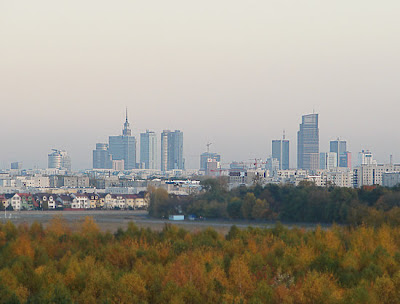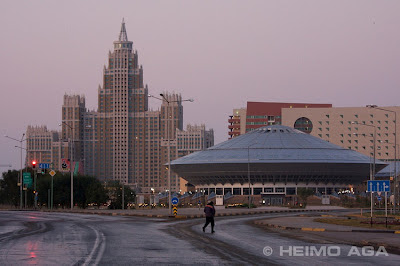[slightly changed version of an essay that appeared on the Afterall.org online]
Whatever happened to the architecture of the Eastern Bloc? The shock
therapy brought in 1989 to install capitalism economically meant a year zero
between the past and the present, shattering all the previous networks between
countries. What followed was the biggest decline since Great Depression. The late
communist economy, a distant shadow of original socialist ideas, dragged down every other dimension of life, erasing also the
way cities were planned. Urban and social planning disappeared for the sake of
a so-called ‘freestyle’ in architecture, reflecting the new methods of the free market.
Suddenly, many carefully planned cities in the ex-Bloc started to look like
cheap, Third World versions of North American über-capitalist
cities, with horrifically lumpen versions of skyscrapers and financial
districts. This so-called ‘style’, characteristic of
so many post-Soviet metropolises (most of all, Moscow
The term was actually coined on the occasion of an
exhibition by the West German group of painters, like Gerhard Richter, Sigmar
Polke or Wolf Vostell in Dusseldorf
Who was building these new edifices? Did the architects of the previous system disappear? In Poland
often the very same architects, whose practices had
been privatized, embraced the new
reality, and designed Poland ’s
new parodies of New York and Chicago North Africa , to work on building and city-planning projects. In
recent years, architectural historian Lukasz Stanek and his collaborators at the ETH in Zurich
In the new capitalist architecture, the legacy of the socialist times
was still visible, now expressed through the most grandiose and then-hated
reminder of the old regime, Socialist Realism. Many tend
to see Socialist and Capitalist Realisms as oppositional ideologies,
which obscures how much they have in common. Traditionalism, nationalism,
symmetries, grand scale – all that is reflected in both architectural styles.
For example, the 90s and 00s skyscrapers of Moscow and Astana were directly
modeled after those of late 40s and 50s Moscow and Warsaw, which in turn had
been inspired by 1910s Chicago. What happened between Stalinist Socialist realism and Capitalist Realism were three decades of Modernism, mostly in the
form of prefabricated social housing. The model for
this actually came from pre-War
experiences. Poland USSR ,
Modernism ceased in the early 1930s when the General Plan for rebuilding Moscow
The new socialist realist style, deployed
after the Second World War, has effects that
are still visible in all ebuilt
Eastern Bloc cities. Those Polish cities, like Warsaw Warsaw - a steelworks
colony, built by an outrageous effort between 1949 and 1954 in suburban Krakow in a grandiose Socialist Realist style, with boulevards wide enough to be able
to host tanks in case of the Third World War. This was the reality of the Cold
War – a constant competitiveness in all fields including technology, which the
Soviet Bloc could mostly win only by propaganda. But where did the rest of the
postcolonial world fit in this division?
In the ‘thaw’ of 1956 Boleslaw
Bierut, the Communist Party of Poland, died,
and was replaced during great turmoil by Władyslaw Gomułka, who
criticized the period of Socialist Realism as “the era of errors and
distortions”. This event opened a new chapter
in Polish planning and architecture. What was from
then state-supported was entirely opposed to the totalitarian opulence of the
Stalinist Palaces of Culture - cheap, prefabricated blocks of flats. With a housing crisis still pervading society after
the war, the quickly built, though initially well-planned estates started to
fill the cities in the whole Bloc. Interestingly, this spectacular achievement
put Eastern Bloc architects at the frontline of new ideas for housing
solutions, as masterplanners and city constructors.
The success of this attracted ‘developing’ countries from outside the
Eastern and Western Blocs to hire the cities’ planners
and architects. Large state-owned
national architectural practices like Miastoprojekt from
Krakow or Energoprojekt from Belgrade Baghdad ’s
master plan in 1967, a
general housing programme for Iraq Middle East until the 1980s.
The founding of and collaboration with the Non-Aligned
Movement was part of the geo-political development of a ‘third way’ between capitalism and communism. And there was a lot in between: the oil-rich Middle East,
Africa emerging from colonial rule and Latin America .
They were all underdeveloped and needed new kind of cities and housing. The
fact that socialist Poland in the exhibition ‘PRL™ Export Architecture and
Urbanism from Socialist Poland’[4] at the Warsaw Museum of Modern Art in 2010. The exhibition showed conclusively
how the USSR Poland Poland
Until a certain moment Polish skills and
techniques were highly desirable. They stopped
being so in the late 1970s, when imperialism
moved into the Non-Aligned nations, forcibly
shifting alignments: Indonesia
faced a US-backed coup in the 1960s; Egypt reconciled itself to the USA after Sadat became
president and in Iraq ,
Saddam Hussein similarly had the USA
Rather than being modern, from this point former Non-Aligned countries were keen to market themselves as tourist destinations and started to favour more traditional architectural styles, exoticising their otherness. Meanwhile, countries that became wealthy from oil in the 1970s soon had the wealthiest ruling class in the world. Thus they wanted to build aptly representational buildings, focusing less on housing and basic infrastructure and more on display. One can endlessly ask the question of what caused the rise of postmodernism, but it is clear that the reaction happened everywhere. Each country, in the First, Third and Second Worlds, had adopted modern architecture, so in the end an attack was made across the board on a style apparently boring, monolithic and monofunctional.
The replacement was a corporate and parodic aesthetic. Much of the
criticism and pomo ideology came from the US
The problem there now, is the light and space permanently taken by corporate high-rises built onto the parkland originally between the blocks. It’s an interesting example of how modernist zoning (the area was zoned solely for housing) was replaced and crowded by banks, office blocks and restaurants, that all belong not only to another ‘zone’, but another social class. When the influential American writer Jane Jacobs opposed zoning, she was opposing the tendency of spaces in estates to become bleak and abandoned. But what followed was the insistance on making places “vibrant”. In the case of the Iron Gate, this meant building around the monolithic, huge and identical Ville Radieuse-style blocks in green space a net of significantly higher, clad with an especially cheap and perishable material - trespa, speculation flats & and imposing office/retail developments like Atrium. Its architects even quote Socialist Realism as a source of inspiration: “It is the only contemporary style noticeable and consequently realized inWarsaw
The problem there now, is the light and space permanently taken by corporate high-rises built onto the parkland originally between the blocks. It’s an interesting example of how modernist zoning (the area was zoned solely for housing) was replaced and crowded by banks, office blocks and restaurants, that all belong not only to another ‘zone’, but another social class. When the influential American writer Jane Jacobs opposed zoning, she was opposing the tendency of spaces in estates to become bleak and abandoned. But what followed was the insistance on making places “vibrant”. In the case of the Iron Gate, this meant building around the monolithic, huge and identical Ville Radieuse-style blocks in green space a net of significantly higher, clad with an especially cheap and perishable material - trespa, speculation flats & and imposing office/retail developments like Atrium. Its architects even quote Socialist Realism as a source of inspiration: “It is the only contemporary style noticeable and consequently realized in
Some of the new ideas came from Polish architects’ earlier adaptation of
modernist rules to changing local conditions in their Non-Aligned clients. This
is too easily read as an embrace of ‘freedom’. In fact, Middle East countries,
such as Iraq or Kuwait were much more harsh and undemocratic
than any Eastern Bloc country - they treated their political opponents in a
much more brutal way than General Jaruzelski did after introducing Martial Law
in Poland
In 1991 Miastoprojekt Krakow transformed itself into a trade company,
consisting of fifteen different offices
coordinating the overall practice. The highlights of their practice include,
for instance, the headquarters for Philip
Morris in Krakow . The planners of cities first
in Poland and then the Middle East have become the designers of malls, banks,
conference centres, private villas and
speculative offices. It’s this movement, from involvement in the Non-Aligned
countries before 1989 and then new buildings in Poland
It would be interesting to more closely examine
the strange recurrence of Socialist Realism, first, as the USSR ’s equivalent of the
capitalist architecture of the US Ukraine
to Kazakhstan and Uzbekistan , and even extends to oil-garchies Bahrain and Saudi Arabia Mecca
These recent projects and exhibitions on the many worldwide legacies of socialist architecture ask some pointed questions about where we might position the ‘centre’ and ‘periphery’. We find first, an authoritarian Socialist Realist style abandoned in the late ‘50s which is then evoked, stripped of its direct political associations in the new capitalist architecture of the 1990s; and when we try and find out where this evocation of demonized styles comes from, we find the experiences of architects forced to adapt to new trends from the west. Nothing is certain, nothing corresponds to the cliché of totally hostile rival Blocs. More than anything else, we find an era and an architecture that was struggling for alternative scenarios of modernity, rather than limiting itself to a familiar dichotomy between Empires East and West.
[1] Bart Goldhoorn and
Philipp Meuser, Capitalist Realism: New
Architecture in Russia , Berlin
[3] The Non-Aligned Movement, like the similar Group of 77,
was founded during a thaw in the Cold War in 1961 in Belgrade
to unite the ‘Third World ’ countries that were
neither a part of the capitalist West nor the Eastern communist Bloc.)
[4] Exhibition carried out by ETH Zurich's Lukasz Stanek and Piotr Bujas http://www.south-of-eastwest.net/index.php?id=1
[5] Heidrun Holzfeind, Za Zelazna Brama (Behind the Iron Gate) http://www.heidrunholzfeind.com/ZZB.html
[6] Quoted from a leaflet of the exhibition.






No comments:
Post a Comment